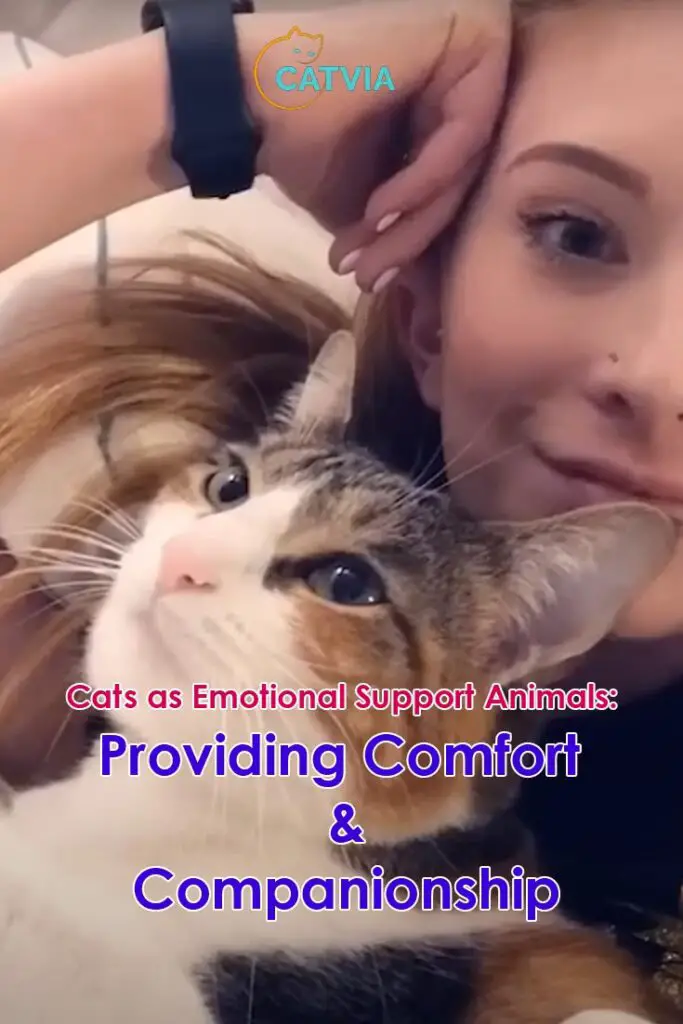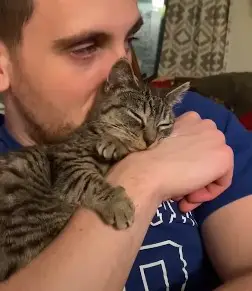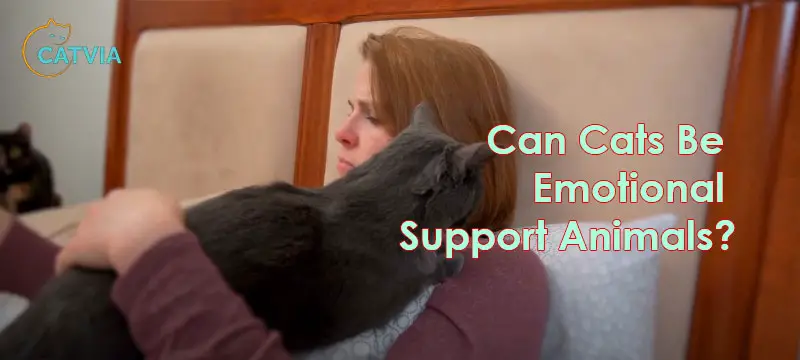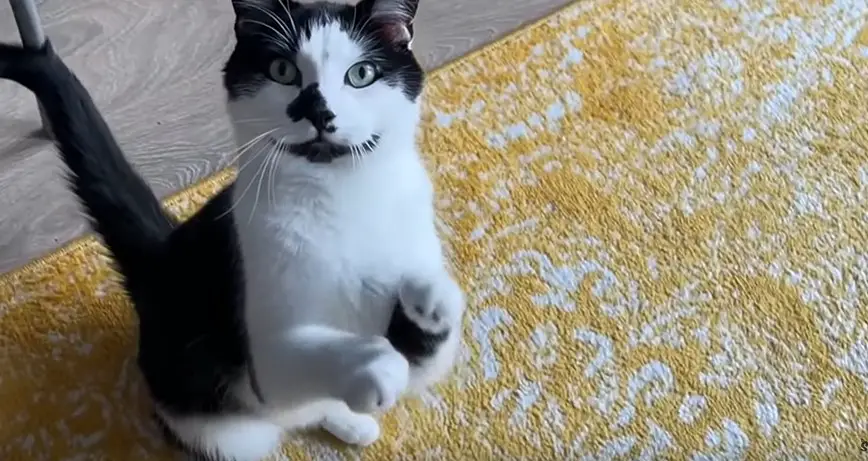Yes, cats can be emotional support animals (ESAs). An emotional support animal is a pet that provides companionship and emotional support to a person with a mental or emotional disability.
Unlike service animals, ESAs do not have to be trained to perform specific tasks. They simply need to be able to provide emotional support to their owner.
Cats can be great emotional support animals for a variety of reasons. They are often independent and low-maintenance, which can be helpful for people with anxiety or depression.
Cats can also provide a sense of security and comfort, and their purring has been shown to have calming effects.
What is Emotional Support Animals?
Emotional support animals are different from service animals and therapy animals. ESAs are not trained to perform specific tasks like service animals but to provide emotional comfort to their owners.

Laws like the Fair Housing Act and the Air Carrier Access Act protect the rights of ESA owners, allowing them to live with their animals and travel with them for emotional support.
What are the Benefits of Emotional Support Animals?
Emotional support animals offer several benefits for mental health. Spending time with an ESA can reduce feelings of loneliness, anxiety, and depression.
Scientific research shows that interacting with animals can lower stress hormones and increase the production of “feel-good” chemicals in the brain, like serotonin and oxytocin.
People with conditions such as anxiety, depression, and post-traumatic stress disorder (PTSD) often find solace in the presence of an ESA.
Cats as Emotional Support Animals: Why They Matter
Cats possess unique qualities that make them suitable as ESAs. Their gentle nature, soothing purring, and soft fur can have a calming effect on their owners.
Cats are also relatively low-maintenance pets, which can be helpful for individuals who might find it challenging to care for high-energy animals.
The companionship of a cat can be especially valuable for those who need a quiet and understanding presence.
Legal Considerations and Requirements
To have a cat designated as an ESA, certain steps need to be followed. A mental health professional must provide a recommendation letter stating that the individual would benefit from an ESA.
This letter is crucial for gaining housing and travel privileges with the cat. While there is no official registry for ESAs, having proper documentation is vital for exercising the rights granted by law.
The Cat-Human Connection: How Cats Fulfill Emotional Needs
The bond between humans and cats is unique and heartwarming. When people interact with cats, their bodies release oxytocin, a hormone linked to social bonding and stress reduction.
This chemical reaction contributes to the feelings of comfort and emotional connection that cats provide. The gentle touch of a cat or the act of simply being in its presence can have a positive impact on an individual’s mental state.
Case Studies: Real-Life Examples
Real-life stories highlight the difference that cats can make as ESAs. Sarah, for example, struggled with severe anxiety. When she adopted a cat named Luna, she found that Luna’s gentle demeanor and playful antics provided a welcome distraction from anxious thoughts.
Another person, Michael, found comfort in his cat, Whiskers, after experiencing trauma. Whiskers’ unwavering companionship helped Michael rebuild his sense of security and trust.
Responsibilities of Cat Owners with ESAs
Owning an ESA cat comes with responsibilities. It’s crucial to provide proper care, including regular veterinary check-ups, a balanced diet, and a safe environment.
Cats also need mental and physical stimulation, so engaging in playtime and providing toys is essential. Integrating the cat’s needs into one’s daily routine ensures a healthy and happy partnership.
Potential Drawbacks and Considerations
While the benefits of ESA cats are clear, there are some potential challenges. Allergies to cat dander can be a concern, as well as navigating housing situations that might not be pet-friendly.
Some public places might have restrictions on animals, even if they are ESAs. It’s important to weigh these challenges against the positive aspects of having a cat as an ESA and make an informed decision.
How to Register a Cat as an Emotional Support Animal for Free in USA
If you are looking to register your cat as an emotional support animal for free, the best thing to do is to talk to your doctor or therapist. They can help you determine if an ESA is right for you and can provide you with the letter you need.

Here are the steps on how to register your cat as an emotional support animal for free in the USA:
- Talk to your doctor or therapist about your mental or emotional disability and whether an ESA would be helpful for you.
- If your doctor or therapist agrees that an ESA would be helpful, they will write you a letter stating that you have a disability and that an ESA is necessary for your treatment.
- Keep a copy of the letter for your records. You may also need to show it to your landlord, school, or other businesses that may have restrictions on pets.
- Your cat is now considered an emotional support animal. You can take them with you in places that normally have pet restrictions, such as on airplanes and in housing.
It is important to note that ESAs do not have the same rights as service animals. Service animals are trained to perform specific tasks for people with disabilities, such as opening doors or picking up dropped items. ESAs are not required to be trained to perform any specific tasks.
However, ESAs are still protected by the Fair Housing Act (FHA) and the Air Carrier Access Act (ACAA). The FHA prohibits landlords from discriminating against tenants with disabilities who have ESAs. The ACAA requires airlines to allow passengers with ESAs to travel with their animals in the cabin of the plane.
If you have any questions about registering your cat as an emotional support animal, you should talk to your doctor or therapist. They can help you understand the law and your rights.
Emotional Support Cats vs. Therapy Cats vs. Service Animals
Emotional support animals (ESAs), therapy animals, and service animals are all different types of animals that can provide companionship and support to people with disabilities. However, there are some key differences between these three types of animals.
Here is a table that summarizes the key differences between ESAs, therapy animals, and service animals:
| Type of Animal | Requirements |
|---|---|
| Emotional Support Animal (ESA) | Must be a pet that provides emotional support to a person with a mental or emotional disability. Does not have to be trained to perform specific tasks. Protected by the Fair Housing Act (FHA) and the Air Carrier Access Act (ACAA). |
| Therapy Animal | Must be trained to provide comfort and support to people in a variety of settings. Not considered service animals under the law. Not protected by the ADA. |
| Service Animal | Must be trained to perform specific tasks for a person with a disability. Protected by the Americans with Disabilities Act (ADA). Allowed to accompany their handlers in all public places. |
FAQs
How do I know if my cat is an emotional support animal?
To have your cat officially recognized as an emotional support animal (ESA), consult a mental health professional. They’ll assess your emotional needs and provide a recommendation letter if an ESA is beneficial for you. This letter is crucial for legal rights and privileges related to housing and travel.
Can cats help with anxiety?
Yes, cats can help with anxiety. Their calming presence, soft fur, and gentle purring have been shown to reduce stress and anxiety levels. The act of petting and bonding with a cat triggers the release of chemicals in the brain that promote relaxation and emotional well-being.
Do cats help with depression?
Yes, cats can help with depression. The companionship and routine care that cats offer can provide a sense of purpose and structure, alleviating feelings of emptiness and isolation. Interacting with cats boosts the production of “feel-good” hormones, contributing to improved mood.
Are cats better for emotional support?
Cats can be excellent emotional support animals, but what’s “better” depends on individual preferences. Cats are low-maintenance, offer soothing companionship, and have unique qualities that resonate with some people. Ultimately, the choice between cats and other animals as emotional support depends on personal connection and lifestyle.
Conclusion
In conclusion, cats have proven themselves to be excellent emotional support animals. Their gentle and independent nature, combined with the positive effects of the human-animal bond, can significantly contribute to improved mental health.
For individuals considering an ESA cat, it’s essential to consult a mental health professional, understand the legal requirements, and be prepared to provide the care and attention that a feline companion deserves.
With the right guidance and commitment, cats can offer unwavering comfort and companionship on the journey toward better mental well-being.
His professional interests include humane education, ethics, small animal behavior, and veterinary. As a pet lover from school life, having grown up with two cats and a dog. If he isn’t spending time with his friends and family, Justin enjoys traveling. Learn more about Justin here.




